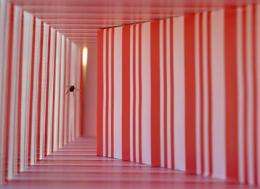How do honeybees control their flight speed to avoid obstacles?

Unlike humans, bees have a dorsal visual field that enables them to avoid obstacles above their heads. Until now, it was not known whether this helped them to control their flight speed. Recent research by French biorobotics specialists at the Institut des sciences du movement confirms that it does. Bees have been shown to adjust their speed according to obstacle proximity, whether such obstacles are in the horizontal or vertical plane. They achieve this through perceived optic flow, especially from overhead. These findings were recently demonstrated experimentally using previously modeled honeybee flight navigation in three dimensions. They were published on 12 May, 2011 in the journal PLoS One.
How can a creature as tiny as a bee, whose brain is proportionally smaller than that of a bird, manage to control its flight and avoid obstacles both in flight and on the ground? We now know that bee sensory-motor performance depends on a nervous system consisting of a hundred thousand to a million neurons. As the insect flies, an image of its environment moves from the front to the back of its visual field, creating an optic flow, which is defined as the angular speed of environmental contrasts passing though its visual field. By definition, these optic flows depend on the relationship between speed and distance from the nearest surfaces.
The researchers already developed a honeybee flight simulation model, called ALIS, last year. ALIS can reproduce insect trajectories primarily using computer-processed visual data (the objects that are present and their movements). These biorobotics specialists then built a flight chamber, with a complex geometric shape, that foraging bees slowly learned to cross to reach a reward of sugar water. This flight chamber had several constrictions where the floor and ceiling, or the side walls, converged. The researchers observed that a bee's speed decreased in proportion to the narrowest point of passage in the flight chamber, whether the constriction was horizontal or vertical. In other words, a bee slows its flight speed as an obstacle gets closer. Its speed depends on the size of the visual field and, therefore, on the closeness of the obstacle. This behaviour was well predicted by the ALIS model simulation: the trajectories of bees flying in the flight chamber corresponded perfectly to the trajectories predicted by virtual insect modeling.
The scientists point to the existence of controllers that maintain the optical flows, i.e., visually-perceived speed/distance, at constant values. Thus, if the insect is flying in an environment that is becoming increasingly crowded, this "cruise control" forces it to reduce its speed in order to maintain constant speed/distance. An "optic flow regulator" model makes it possible to understand how a bee is able to fly without ever needing to measure its speed or its position from the walls and how it can do without traditional aerospace sensors, like Doppler radars, that give speed in relation to the ground. These ultra-precise sensors have the disadvantage of being bulky, expensive and power consuming. The present research illustrates the dual challenge of biorobotics, both in fundamental and applied research. These findings could have aerospace applications, such as during the crucial phases when aircraft fly in confined environments.
More information: Honeybees' speed depends on dorsal as well as lateral, ventral and frontal optic flows. G. Portelli, et al. PLoS One, 12 mai 2011.
Provided by CNRS



















